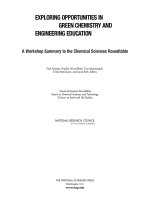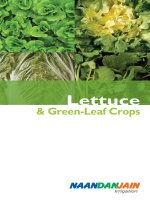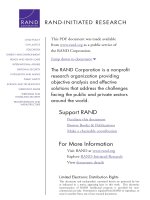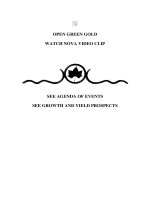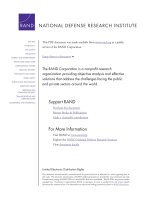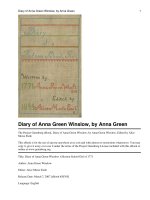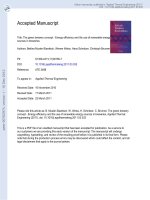Green Garment Factory
Bạn đang xem bản rút gọn của tài liệu. Xem và tải ngay bản đầy đủ của tài liệu tại đây (1.37 MB, 92 trang )
Green Garments Guidebook
Improving Environmental Performance
in Saipan’s Garment Manufacturing Industry
A Joint Project of:
Tetra Tech EM Inc. September 2006
Green Garments Guidebook i
Table of Contents
PREFACE iii
A SNAPSHOT OF A GREEN GARMENT FACTORY (EXECUTIVE SUMMARY) iv
1.0 GARMENT MANUFACTURING IN SAIPAN 1
1.1 GREEN GARMENTS PROJECT 1
1.2 GARMENT MANUFACTURING AND GLOBAL TRADE 2
2.0 OVERVIEW OF GARMENT MANUFACTURING OPERATIONS 4
2.1 MANUFACTURING PROCESSES 4
2.2 SUPPORTING OPERATIONS 9
3.0 ENVIRONMENTAL FOOTPRINT OF A GARMENT 12
3.1 GLOBAL REPORTING INITIATIVE ENVIRONMENTAL PERFORMANCE
INDICATORS
12
3.2 GARMENT MANUFACTURING ENVIRONMENTAL FOCUS AREAS 14
3.3 ENERGY USE 16
3.4 WATER USE 19
3.5 SOLID WASTE GENERATION 20
3.6 HAZARDOUS CHEMICAL USE 22
4.0 FOCUS AREA 1: ENERGY USE 23
4.1 EPA ENERGY STAR PROGRAM 25
4.2 CONDUCTING AN ENERGY AUDIT 27
4.3 LIGHTING 30
4.4 SUPPLEMENTAL LOAD REDUCTIONS 35
4.5 HEATING AND COOLING SYSTEM UPGRADES 36
4.6 BOILER SYSTEM UPGRADES 37
5.0 FOCUS AREA 2: WATER USE 39
5.1 LAUNDRY 41
5.2 BOILER OPERATION 43
5.3 DORMITORY BATHROOMS 44
Green Garments Guidebook ii
Table of Contents (continued)
6.0 FOCUS AREA 3: SOLID WASTE GENERATION 52
6.1 GARMENT SCRAP RECYCLING 54
6.2 DIVERTING OTHER RECYCLABLE MATERIALS 56
6.3 DIVERTING FOOD SCRAP WASTE 57
7.0 HAZARDOUS CHEMICAL USE 61
7.1 MINIMIZE SPOTTING OCCURRENCES 63
7.2 MINIMIZE SOLVENT USE THROUGH EFFICIENT APPLICATION 64
7.3 USE ALTERNATIVE SPOT REMOVAL TECHNIQUES 65
7.4 USE ALTERNATIVE SPOT-REMOVING AGENTS 65
7.4 ENSURE PROPER CHEMICAL STORAGE 68
8.0 MARKETING ENVIRONMENTAL PERFORMANCE 70
8.1 MARKETING ENVIRONMENTAL PERFORMANCE TO CUSTOMERS 70
8.2 EMPLOYEE AND RESIDENT OUTREACH 71
9.0 RETAILERS GREENING THE SUPPLY CHAIN 75
10.0 REFERENCES AND FURTHER READING 77
11.0 VENDOR INFORMATION 79
Green Garments Guidebook iii
PREFACE
Tetra Tech EM Inc. (Tetra Tech) prepared this Guidebook with funding from the U.S.
Environmental Protection Agency (EPA), administered through the Commonwealth of
Northern Mariana Islands (CNMI) Division of Environmental Quality (DEQ), and endorsed by
the Saipan Garment Manufacturers Association (SGMA). Dave Hodges and Jim Callier
managed the project for CNMI DEQ; Patrick Wooliever and Marcella Thompson (Tetra Tech)
were the primary authors of this guidebook and may be contacted at (415) 222-8240 or
The Green Garments Project aims to help member companies improve their competitiveness
and environmental performance by identifying best management practices (BMP) that
conserve water and energy, use less-toxic chemicals, and minimize waste. Companies that
implement the recommended BMPs can realize multiple benefits, including: cost savings,
improved worker conditions, reduced risk of regulatory problems, and decreased impact on
the local environment and community.
The following SGMA member companies dedicated significant time and resources to the
development of this Guidebook by providing Tetra Tech with facility tours and real operating
data:
Concorde Garment Manufacturing
Jin Apparel
Michigan
Onwel Manufacturing
US CNMI Development
Commonwealth Garment Manufacturing
Marianas Garment Manufacturing
Mirage Saipan
United International
The Green Garments Project also solicited the participation of international stakeholders to
broaden the impact of this project, including the Global Reporting Initiative (GRI) team
developing the Apparel and Footwear Sector Supplement and major retailers to raise
awareness and increase demand-side support for the project. Ultimately, the Green
Garments Project hopes to help improve the environmental performance of garment
manufacturers in Saipan and
elsewhere in this global industry.
Green Garments Guidebook iv
A SNAPSHOT OF A GREEN GARMENT FACTORY (EXECUTIVE SUMMARY)
Instead of the customary “Executive Summary,” the Green
Garments Project believes that readers of this Guidebook are
most interested in what features characterize an
environmentally-efficient garment factory and how the facility
they work in, or with, compares. Whether you are from within
the industry and trying to assess your factory relative to
competitors, or an interested customer, auditor, or regulator,
what features characterize a garment manufacturer doing
business in a manner that is “ahead of the curve”
environmentally?
Such an evaluation is inherently subjective and complex, and the resulting “score” or
“grade” is always relative. But often the evaluation exercise is more valuable than the final
determination: collecting data and asking questions reveals the weaknesses in
environmental management and implementation. So, what does a “Green Garment” factory
look like? This Guidebook offers two measuring sticks:
1. Benchmarks for the most important resources used in each of the four Guidebook
environmental focus areas: energy, water, solid waste, and hazardous materials.
2. A checklist of environmental best management practices (BMP) for garment
manufacturing factories.
Environmental Benchmarks for Saipan Garment Factories
One goal of the Green Garments Project was to determine quantitative measures of the
environmental impacts of a garment factory. The environmental footprint of a typical
Saipan garment factory can be divided between activities associated with (a) manufacturing
processes and (b) on-site dormitories. Using actual operating data from nine Saipan
garment factories between May 2004 and May 2005, the Green Garments Project
determined normalized averages for energy use, water use, and solid waste generation.
When available, this Guidebook also provides comparative data from other garment
manufacturers in Asia and the U.S. mainland. Benchmarks derived from simple statistical
methods and judgments are also provided for Saipan garment factories. Recognizing that
even with all other variables being equal, the factories have different requirements for
resources (for example, some factories perform more labor-intensive finishing processes).
While the benchmarks for each metric are aggressive, the Green Garments project still
believes they are attainable by most, if not all the garment factories.
Lastly, the data show that the environmental impact of on-site worker housing dormitories
is a smaller, but still significant component of the typical overall garment factory in terms of
water and energy use. Because factories control the operations and resulting environmental
A SNAPSHOT OF A GREEN GARMENT FACTORY
Green Garments Guidebook v
impact of on-site dormitories, this Guidebook also includes recommendations for this facet
of the garment factories.
ENVIRONMENTAL FOOTPRINT FOR SAIPAN GARMENT FACTORIES*
Manufacturing Operation
per 1,000 pieces
Employee Housing
per resident, per day
Environmental Focus Area
Average Benchmark Average Benchmark
Energy Use
kilowatt hour (kw-hr)
435 271 4.55 2.99
Water Use
gallons (gal)
1,773 1,086 72.3 55.6
Solid Waste Generation
pounds (lbs)
200 126
Hazardous Chemical Use
pounds (lbs)
NA
NA
* Because garment factories in Saipan only cut and sew bulk fabrics to create garments, this data excludes the environmental
impacts associated with textile manufacturing. While not insignificant, the environmental impacts associated with cutting and
sewing are less substantial than those resulting from fabrication and dyeing processes.
NA Not available. Data on solid waste generation and hazardous material use from the Garment Factory Dormitories was
unavailable, but also very small compared to the manufacturing component.
Garment Manufacturing Environmental Checklist
The following Garment Manufacturing Environmental Performance Checklist is designed to
assist garment factories and their retail customers in integrating environmental performance
monitoring into existing management programs. Global Reporting Initiative (GRI)
environmental performance indicators have been noted for each category, and additional
information for most recommended BMPs can be found throughout this Guidebook.
This checklist is wholly based on findings from the Green Garments Project in Saipan, which
encompasses the garment manufacturing processes described in Section 2 of this
Guidebook. Therefore, the checklist does not directly address other environmental impacts
that are associated with the textile manufacturing process. Furthermore, this checklist
should be viewed only as a starting point for sustainable practices and used to initially
gauge the environmental performance of garment factories. Even if a garment factory has
achieved everything on the checklist, countless other opportunities exist to further minimize
environmental impacts. Lastly, the checklist is specific to local conditions in Saipan and its
application in other geographic areas or non-tropical climates may require modification to
better reflect locally available pollution prevention (P2) opportunities and operating
conditions.
A SNAPSHOT OF A GREEN GARMENT FACTORY
Green Garments Guidebook vi
KEY FINDINGS OF THE GREEN GARMENTS GUIDEBOOK
In analyzing the raw data that supports the charts and tables in this section, it is important
to keep the “big picture” firmly at the forefront of your thinking, namely:
The big P2 opportunities are not exotic. The four environmental focus areas in
this Guidebook highlight reduction opportunities that are not unique to the industry,
nor do they require hard-to-find equipment or poorly understood techniques.
Bottom line?
1. Conduct an energy audit and prioritize actions.
2. Conduct a water audit and prioritize actions.
3. Segregate and recycle fabric scraps.
4. Identify and eliminate the cause of spots quickly and use what spot
cleaners are required sparingly. Eliminate chlorinated solvents if at all
possible.
Garment manufacturing is a smaller piece of the overall garment
environmental footprint. The portion of the overall garment footprint represented
by most garment manufacturing factories like those in Saipan is smaller than that of
textile manufacturing, the other major part of producing garments that includes
fabrication, dyeing, weaving and spinning. Garment manufacturing activities—
including cutting, sewing, ironing and packing—are still significant and should be
controlled and made efficient, but their impacts area smaller and less chemical-
intensive.
Cost savings are abundant. The cost/benefit analysis for the P2 opportunities in
three of the focus areas, energy, water, and solid waste, are relatively easy to
determine and the payback period for nearly all of them is between 6 months and 2
years (…and shorter if CUC rates, diesel prices, or tipping fees continue to increase).
Green Garments Guidebook vii
GARMENT MANUFACTURING ENVIRONMENTAL PERFORMANCE CHECKLIST
SAIPAN GREEN GARMENTS PROJECT
POLICIES AND PROCEDURES
Addresses GRI Governance Structure and Management Systems requirements.
1. Does the organization track environmental performance metrics? Yes No
2. Does the organization have an environmental policy statement
endorsed by executive management?
Yes No
3. Has the organization implemented an environmental management
system?
Yes No
3.1 If yes, is it ISO 14001 certified? Yes No
ENERGY USE
GRI Environmental Performance Indicators EN3, EN4
4. Does the organization track a normalized energy-use metric? Yes No
If yes, attach documentation and record normalized
average energy use per month here:
5. Has the organization performed a formal energy audit and identified
energy efficiency opportunities?
Yes No
6. Has the organization conducted a formal study to determine
appropriate lighting levels for each process or task?
Yes No
7. Has the organization optimized current lighting systems using any
of the following? (Check all that apply.)
Adjust light proximity
Task lighting
Automatic light controls
Cleaning/maintenance
Group replacement
Other:
8. Has the organization upgraded lighting systems with any of the
following energy-efficient technologies? (Check all that apply.)
Electronic ballasts
Hybrid ballasts
T8 or T5 lamps
Compact fluorescent
LED exit signs
Other:
Green Garments Guidebook viii
GARMENT MANUFACTURING ENVIRONMENTAL PERFORMANCE CHECKLIST
SAIPAN GREEN GARMENTS PROJECT
ENERGY USE (continued)
GRI Environmental Performance Indicators EN3, EN4
9. Does the organization have a documented environmentally
preferable purchasing policy that includes preference to energy-
efficient products? If yes, describe below:
10. Has the organization installed an energy-efficient heating or cooling
system? If yes, describe below:
11. Does the organization operate a boiler for steam generation or
other use?
Yes No
If yes, does the organization have a written maintenance
schedule to inspect the system for steam leaks?
Yes No
If yes, describe any upgrades or programs the organization
has implemented to improve the energy-efficiency of the
boiler.
WATER USE
GRI Environmental Performance Indicator EN5
12. Does the organization track a normalized water-use metric? Yes No
If yes, attach documentation and record normalized
average water use per month here:
13. Does the organization have a documented leak detection program? Yes No
14. Does the organization have an on-site laundry operation? Yes No
If yes, does the organization track the water used per
pound of material washed? If available, specify here:
Yes No
If yes, indicate whether the organization has implemented
any of the following water conservation technologies (check
all that apply).
Batch washer system
Water recovery tanks
Ozone washing
Other:
Green Garments Guidebook ix
GARMENT MANUFACTURING ENVIRONMENTAL PERFORMANCE CHECKLIST
SAIPAN GREEN GARMENTS PROJECT
WATER USE (continued)
GRI Environmental Performance Indicator EN5
15. Does the organization operate a boiler for steam generation or
other use?
Yes No
If yes, is a boiler condensate recycling system installed? Yes No
16. Do bathroom facilities for employees used during normal
operating hours have low-flow features?
Yes No
If yes, indicate whether the organization has implemented
any of the following water conservation technologies for
toilets (check all that apply).
Low-flush toilet
(1.6 gallons per flush)
Early closure valve
Weighted flapper
Dual flush device
Displacement bag
Toilet dam
17. Does the organization provide bathroom and shower facilities for
use by residents in on-site dormitories?
Yes No
If yes, indicate whether the organization has implemented
any of the following water conservation technologies for
toilets (check all that apply).
Low-flush toilet
(1.6 gallons per flush)
Early closure valve
Weighted flapper
Dual flush device
Displacement bag
Toilet dam
If yes, do the installed showerheads use less than 2.2
gallons of water per minute?
Yes No
Green Garments Guidebook x
GARMENT MANUFACTURING ENVIRONMENTAL PERFORMANCE CHECKLIST
SAIPAN GREEN GARMENTS PROJECT
SOLID WASTE GENERATION
GRI Environmental Performance Indicators EN11
18. Does the organization track a normalized solid waste metric? Yes No
If yes, attach documentation and record normalized
average solid waste generation per month here:
19. Does the organization recycle scrap garment materials? Yes No
20. Indicate which commodities the organization recycles (check all that
apply).
Aluminum cans
Batteries
Cardboard
Glass
Scrap metals
Other:
Other:
HAZARDOUS CHEMICAL USE
GRI Environmental Performance Indicators EN1, EN11, EN13
21. Does the organization maintain an electronic inventory of all
hazardous chemicals used on site?
Yes No
22. Does the organization track a normalized hazardous chemical use
metric?
Yes No
If yes, attach documentation and record normalized
average hazardous chemical use per month here:
23. Does the organization have a spot removal operation? Yes No
If yes, refer to the spot remover/solvent MSDS to specify
the health and safety characteristics of the product (check
all that apply).
Carcinogenic
Teratogenic/Mutagenic
Neurotoxic
Green Garments Guidebook xi
GARMENT MANUFACTURING ENVIRONMENTAL PERFORMANCE CHECKLIST
SAIPAN GREEN GARMENTS PROJECT
ENVIRONMENTAL COMPLIANCE
GRI Environmental Performance Indicators EN16
24. Has the organization previously had incidents of, or fines
associated with noncompliance of applicable environmental laws
and regulations? If yes, describe below:
Yes No
25. Specify the local environmental regulatory agencies below:
Green Garments Guidebook 1
1.0 GARMENT MANUFACTURING IN SAIPAN
Over the past 20 years, Saipan has become an important player in the world garment
manufacturing industry, which has grown and evolved to meet consumers’ ever-changing
and burgeoning demand worldwide for the latest clothing styles. At the same time, the
industry sector has come under increasing scrutiny as a result of high-profile examinations
of labor practices and working conditions at
manufacturing facilities around the globe. To meet
pricing pressures, the most successful retailers have
exercised their clout to demand lower wholesale prices
from suppliers and have sourced goods from a wider
and wider pool of manufacturers. In this squeeze
between cost and globalized sourcing of goods, rapid
change, and extraordinarily competitive markets, the
environmental effects of the industry sector have been
hard to define, evaluate, and control. The industry,
represented in Saipan by the Saipan Garment Manufacturers Association (SGMA), has
responded to the scrutiny of outside organizations by developing a code of conduct that
delineates standards for the treatment of workers, living conditions and worker rights.
The next step in improving performance is to more explicitly address the environmental
issues associated with the industry’s practices. When considering the long-term potential
for a sustainable and successful garment manufacturing industry in Saipan, it is essential to
view the industry’s “environmental performance” as intertwined with other issues such as
working conditions, living conditions, and
manufacturing efficiency and profit. This
Guidebook demonstrates this relationship and
provides recommendations to improve
environmental performance across the industry.
1.1 Green Garments Project
The Green Garments Project is a partnership
between the Commonwealth of the Northern
Mariana Islands (CNMI) Department of
Environmental Quality (DEQ) and SGMA, intended
to help member companies improve their
competitiveness and environmental performance
by identifying best management practices (BMP)
that conserve water and energy, use less-toxic
chemicals, and minimize waste. Companies that
implement the recommended BMPs can realize
multiple benefits, including: cost savings,
FIGURE 1-1 | COMMONWEALTH OF
NORTHERN MARINANA ISLANDS MAP
Saipan is the capitol of the Northern
Mariana Islands, a chain of 14 islands in
the Western Pacific.
In the squeeze between cost
and globalized sourcing of
goods, rapid change, and
extraordinarily competitive
markets, the environmental
effects of the industry sector
have been hard to define,
evaluate, and control.
GARMENT MANUFACTURING IN SAIPAN
Green Garments Guidebook 2
improved worker conditions, reduced risk of regulatory problems, and decreased impact on
the local environment and community.
This Green Garments Guidebook is based on the findings of P2 assessments conducted at
nine SGMA member garment manufacturers (see Figure 1-2). As part of the project,
participating companies provided tours of their respective facilities and shared actual
operating data on several key production and environmental performance metrics. As a
result, this Guidebook quantifies the environmental impacts of the industry and provides
recommendations that are both practical and directly applicable to the industry.
FIGURE 1-2 | GREEN GARMENTS PROJECT SUMMARY
Project Phase Description
Phase I:
Data Collection and P2
Audit
A preliminary Green Garments survey was used to collect basic
company information and assess potential environmental focus areas.
Additional production and environmental data was collected to
determine baseline performance (discussed in Section 3).
On-site pollution prevention (P2) assessments—including facility tours,
operator interviews, and records review—were conducted at 9 garment
manufacturing factories, and 3 other laundry, and screen printing
facilities.
Phase II:
Develop Green Garments
Guidebook
The Green Garments Guidebook was developed based on the results
of the P2 assessments, facility-provided operational data, and
research specific to the garment sector. The Guidebook includes a full
description of recommended BMPs and tips for successful
implementation, expected results, cost and savings, and applicable
vendor information and contacts.
The Green Garments Guidebook was reviewed by SGMA member
companies, various CNMI employees, and other garment industry
professionals.
1.2 Garment Manufacturing and Global Trade
1
After a 10-year transition period, the World Trade Organization (WTO) quota restrictions for
garment products entering the United States were lifted beginning January 1, 2005. As in
many other countries vying in the worldwide garment industry, garment manufacturers in
1
Summarized from “Understanding the World Trade Organization—Textiles: Back in the Mainstream.”
Available online at: />.
GARMENT MANUFACTURING IN SAIPAN
Green Garments Guidebook 3
Saipan have been directly impacted by the demand-side shift resulting from this change in
the global marketplace. From 1974 to 1995, the worldwide textile and garment trade was
governed by the Multifibre Arrangement (MFA), a framework for bilateral agreements or
unilateral actions that established quotas limiting textile and garment imports into countries
whose domestic industries were facing serious damage from rapidly increasing imports.
Contrary to General Agreement on Tariffs and Trade (GATT) principles, the MFA was
replaced with the WTO’s Agreement on Textile and Clothing (ATC), which sought to fully
integrate the sector into normal GATT rules by January 1, 2005. In particular, the ATC
terminated the textile and garment import quotas and prohibited importing countries from
discriminating among exporters.
The end of these import quotas has meant that the demand for goods produced in Saipan is
no longer influenced by international agreements on trade. Instead, new market
equilibrium has emerged as countries previously restricted by the MFA compete for business
without artificial limits on product demand. Competing factories in China pay wages that
are a fraction of those on the U.S. mainland and far less than the Northern Marianas
minimum wage of $3.05 per hour. As a result, China has seemingly flooded the market
with lower-cost garment manufacturing services. Saipan’s garment factories have felt this
pinch with each phase of the ATC, and the results are evident by the declining membership
in SGMA: 11 members during the Green Garments Project, down from 34 member garment
factories in 1999. Saipan’s total garment sales, which reached a high of $1.07 billion in
1999, had dropped to $786 million by 2004, and SGMA estimates that total sales for 2005
will not exceed $500 to $650 million.
2
2
“Saipan’s Garment Industry Hit by WTO,” Islands Business, April 2005.
www.islandsbusiness.com/archives/
The End of the Multifibre Agreement—What it Means for Saipan
The elimination of textile and garment import quotas ultimately means that garment manufacturers in
Saipan are now participating in a wholly competitive global market. The resulting economic implications
require SGMA companies to operate as efficiently as possible to overcome structural differences in labor
costs. The Green Garments Project is intended to help member companies improve their
competitiveness and environmental performance by identifying BMPs that positively impact the bottom
line by conserving water and energy, using less-toxic chemicals, and minimizing waste.
Green Garments Guidebook 4
Textile Manufacturing
• Fabrication/Weaving.
• Dyeing
• Finishin
g
(
stone wash
,
Garment Manufacturing
• Relaxing
• Cutting
• Sewing
• Trimming/Checking/Finish
• Ironing
• Packing/Shipping
Green Garments Guidebook
2.0 OVERVIEW OF GARMENT MANUFACTURING OPERATIONS
Global consumers are often largely unaware of the resources, processes, and infrastructure
required to grow, manufacture, and deliver the goods they purchase. The following sections
summarize the processes required to turn bulk fabric into wearable garments ready for sale
in retail stores throughout the world. The descriptions also provide a process overview for
those unfamiliar with garment manufacturing; sources that provide even more detailed
descriptions of these processes are included in Section 10.0, References and Further
Reading.
2.1 Manufacturing Processes
Garment manufacturing processes include all activities from the point when textiles are
received at the factory, to
when retail-ready garments
are shipped to the
distributor. Some
processes—such as fabric
relaxing, cutting, and
sewing—occur in the
manufacturing of all
garments. Other optional
processes may also be
performed as specified by
the customer, including such things as embroidering, screen printing, and laundering.
Depending on the size of the manufacturing facility, some garment manufacturers choose to
subcontract those optional processes.
Figure 2-1 provides a brief summary of the major processes required to manufacture bulk
textiles into retail-ready garments. Additional information for each of these processes is
included in Sections 2.1.1 through 2.1.8.
FIGURE 2-1 | GARMENT MANUFACTURING PROCESS OVERVIEW
Receiving
Garment factories receive fabrics from overseas textile manufacturers.
Material is temporarily stored in a warehouse until needed for
manufacturing.
OVERVIEW OF GARMENT MANUFACTURING OPERATIONS
Green Garments Guidebook 5
FIGURE 2-1 | GARMENT MANUFACTURING PROCESS OVERVIEW
Fabric Relaxing
Fabric bolts are unrolled to allow material to relax and contract.
Fabric relaxing minimizes shrinkage during washing.
Spreading, Form Layout, and Cutting
The fabric is cut into uniform plies and spread onto the cutting surface.
Forms are then laid out on the top of the spread, and the fabric is cut to
the pattern shapes.
Cutting is performed manually or using a computerized system.
Embroidery and Screen Printing
Optional customer-requested services may be performed to put logos or
other embellishments on garments.
Sewing
Garments are sewn in an assembly-line manner, with the garment
becoming more complete as it progresses down the sewing line.
This step is labor-intensive.
Spot Cleaning and Laundry
Cosmetic flaws, stains, or other spots identified on an assembled garment
may be cleaned using steam, hot water, or chemical stain removers.
Customers may require a garment to be fully laundered after it is sewn
and assembled.
Ironing
Each garment is manually pressed and then folded prior to packaging.
Packaging and Shipping
Garments are tagged, sized, and packaged according to customer
specifications and then shipped to client distribution centers.
OVERVIEW OF GARMENT MANUFACTURING OPERATIONS
Green Garments Guidebook 6
2.1.1 Receiving
Garment factories receive fabric from overseas textile manufacturers in large bolts with
cardboard or plastic center tubes or in piles or bags. The fabric typically arrives in steel
commercial shipping containers and is unloaded with a forklift. Garment factories often
have a warehouse or dedicated area to store fabric between arrival and manufacturing.
2.1.2 Fabric Relaxing
“Relaxing” refers to the process that allows material to relax and contract prior to being
manufactured. This step is necessary because the material is continually under tension
throughout the various stages of the textile manufacturing process, including weaving,
dyeing, and other finishing processes. The relaxing process allows fabrics to shrink so that
further shrinkage during customer use is minimized.
Garment manufacturers perform the relaxing process either manually or mechanically.
Manual fabric relaxing typically entails loading the bolt of fabric on a spinner and manually
feeding the material through a piece of equipment that relieves tension in the fabric as it is
pulled through. Mechanical fabric relaxing performs this same process in an automated
manner.
Many garment manufacturers will also integrate quality assurance into this process to
ensure that the quality of the fabric meets customer standards. This step is performed by
manually spot-checking each bolt of fabric using a backlit surface to identify manufacturing
defects such as color inconsistency or flaws in the material. Fabrics that fail to meet
customer standards are returned to the textile manufacturer.
2.1.3 Spreading, Form Layout, and Cutting
After fabric has been relaxed, it is transferred to the spreading and cutting area of the
garment manufacturing facility. The fabric is first cut into uniform plies and then spread
either manually or using a computer-controlled system in preparation for the cutting
process (see Figure 2-2). Fabric is spread to:
allow operators to identify fabric defects;
control the tension and slack of the fabric during cutting; and
ensure each ply is accurately aligned on top of the others.
The number of plies in each spread is dependent on the fabric type, spreading method,
cutting equipment, and size of the garment order.
Next, garment forms—or patterns—are laid out on top of the spread, either manually or
programmed into an automated cutting system. Lastly, the fabric is cut to the shape of the
garment forms using either manually operated cutting equipment or a computerized cutting
system.
OVERVIEW OF GARMENT MANUFACTURING OPERATIONS
Green Garments Guidebook 7
FIGURE 2-2 | INCLUDE PICTURES OF SPREADING, FORM LAYOUT, OR CUTTING
Saipan garment factories perform both manual cutting (left)
and automated cutting systems (above).
2.1.4 Embroidery and Screen Printing
Embroidery and screen printing are two processes that occur only if directly specified by the
customer; therefore, these processes are commonly subcontracted to off-site facilities.
Embroidery is performed using automated equipment,
often with many machines concurrently embroidering
the same pattern on multiple garments. Each
production line may include between 10 and 20
embroidery stations. Customers may request
embroidery to put logos or other embellishments on
garments (see Figure 2-3).
Screen printing is the process of applying paint-based
graphics to fabric using presses and textile dryers.
Specifically, screen printing involves sweeping a rubber
blade across a porous screen, transferring ink through
a stencil and onto the fabric. The screen printed
pieces of fabric are then dried to set the ink. This
process may have varying levels of automation or may
largely be completed at manually operated stations.
Like embroidery, screen printing is wholly determined
by the customer and may be requested to put logos or
other graphics on garments or to print brand and size information in place of affixing tags.
FIGURE 2-3 | EMBROIDERY
Embroidery machinery with multiple
stations.
OVERVIEW OF GARMENT MANUFACTURING OPERATIONS
Green Garments Guidebook 8
2.1.5 Sewing
Garments are sewn in an assembly line, with the garment becoming more complete as it
progresses down the sewing line (see Figure 2-4). Sewing machine operators receive a
bundle of cut fabric and repeatedly sew the same portion of the garment, passing that
completed portion to the next operator. For example, the first operator may sew the collar
to the body of the garment and the next operator may sew a sleeve to the body. Quality
assurance is performed at the end of the sewing line to ensure that the garment has been
properly assembled and that no manufacturing defects exist. When needed, the garment
will be reworked or mended at designated sewing stations. This labor-intensive process
progressively transforms pieces of fabric into designer garments.
2.1.6 Spot Cleaning and Laundry
In addition to identifying manufacturing defects, employees tasked with performing quality
assurance are also looking for cosmetic flaws, stains, or other spots on the garment that
may have occurred during the cutting and sewing processes. Spots are often marked with a
sticker and taken to a spot-cleaning area where the garment is cleaned using steam, hot
water, or chemical stain removers.
Some customers request that a garment be fully laundered after it is sewn and assembled;
therefore, garment factories often have an on-site laundry or have subcontract agreements
with off-site laundry operations. Commercial laundry facilities are equipped with at least
three types of machines: washers, spinners, and dryers. Some facilities also have the
capability to perform special treatments, such as stone- or acid-washing.
FIGURE 2-4 | GARMENT SEWING ASSEMBLY LINES AND IRONING STATIONS
Typically, large rooms of sewers sit in lines each doing
separate sequential tasks (left). The final step prior to
packing is ironing (above).
OVERVIEW OF GARMENT MANUFACTURING OPERATIONS
Green Garments Guidebook 9
2.1.7 Ironing
After a garment is fully sewn and assembled, it is transferred to the ironing section of the
facility for final pressing (see Figure 2-4). Each ironing station consists of an iron and an
ironing platform. The irons are similar looking to residential models, but have steam
supplied by an on-site boiler. Workers control the steam with foot pedals and the steam is
delivered via overhead hoses directly to the iron. In most facilities, the ironing platforms
are equipped with a ventilation system that draws steam through the ironing table and
exhausts it outside the factory.
2.1.8 Packaging and Shipping
In the last steps of making a product retail-ready, garments are folded, tagged, sized, and
packaged according to customer specifications. Also, garments may be placed in protective
plastic bags, either manually or using an automated system, to ensure that the material
stays clean and pressed during shipping. Lastly, garments are placed in cardboard boxes
and shipped to client distribution centers to eventually be sold in retail stores.
2.2 Supporting Operations
As is the case with many industries, garment manufacturing requires multiple support
operations to enable production in the facility. Many of these support operations are
common to any manufacturing industry, such as administrative functions, facility and
equipment maintenance, and boiler and backup power generator operation. The garment
factories also commonly operate and maintaining on-site employee dormitories. Often the
scale of the support operations is proportional to the production of the facility.
Figure 2-5 provides a brief summary of the support operations for a garment manufacturing
facility. Additional information for each of these processes is included in Sections 2.2.1
through 2.2.5. Not all support operations are present at every garment factory.
FIGURE 2-5 | SUPPORT OPERATIONS FOR GARMENT MANUFACTURING
Administrative Offices
Processing order and preparing invoices
Conducting marketing and sales
Managing human resources
Steam Generation
Onsite boilers centrally generate steam to support ironing operations.
OVERVIEW OF GARMENT MANUFACTURING OPERATIONS
Green Garments Guidebook 10
FIGURE 2-5 | SUPPORT OPERATIONS FOR GARMENT MANUFACTURING
Power Generation
On-site diesel generators provide back-up power, as needed.
Food Preparation
Meals are prepared on-site for employees.
Kitchens are equipped to meet basic food storage, preparation, and
cleaning needs.
Employee Housing
On-site dormitory-style housing is often available to employees at larger
garment factories.
Rooms are most often designed with shared bathrooms and kitchen
areas.
2.2.1 Administrative Offices
The administrative offices associated with a garment manufacturing facility are typically
proportional to the size of the manufacturing operation (i.e. larger factories require more
administrative support). Administrative staff manages corporate functions such as human
resources, finance and accounting, billing, health and safety, and environmental
compliance. Offices are equipped with basic technologies and amenities, such as
computers, facsimile machines, printers, filing equipment, desk space, and meeting rooms.
In some instances, retail customers may also maintain on-site administrative space for
quality assurance personnel.
2.2.2 Steam Generation
All garment factories had an on-site boiler to centrally generate steam for garment ironing.
In most facilities, the ironing boards are attached to a ventilation system that captures the
heat emitted from the iron and exhausts it to the outside environment. The quantity and
size of boilers located on-site is proportional to the manufacturing operation.
2.2.3 Power Generation
Saipan garment factories also maintain and operate on-site diesel-fueled generators as a
source of backup power. The generators are primarily used when (1) island demand for
Commonwealth Utility Corporation (CUC) electricity service exceeds capacity or (2) a
typhoon temporarily causes a power outage.
OVERVIEW OF GARMENT MANUFACTURING OPERATIONS
Green Garments Guidebook 11
2.2.4 Food Preparation
Most Saipan garment factories had an on-site kitchen to prepare meals for employees.
Kitchens are typically equipped with refrigerators and freezers, a food preparation area,
ovens, propane-fueled stoves, and several large sinks. Meals are served in cafeteria-style
manner during set dining hours. Limited food preparation may also occur in the shared
kitchen areas in dormitories.
2.2.5 Employee Housing
Several Saipan garment manufacturers offer on-site housing for employees. Typically
resembling dormitories or military barracks, employees may share a room with up to 5
other employees (determined by the square footage of the room). Housing facilities often
have shared kitchen and bathroom areas, though most often a sink is located in each
worker room. However, rooms with a private bathroom may be available for management
employees.
Green Garments Guidebook 12
3.0 ENVIRONMENTAL FOOTPRINT OF A GARMENT
Environmental footprint is a measure of impact on the global environment.
Much as a foot leaves an impression on beach sand, manufacturing
activities impact the environment. The environmental footprint of a
manufacturing facility encompasses anything that impacts the earth
including transporting supplies and workers and finished goods, using
energy for machinery and heating and cooling, and generating all types of
hazardous and non-hazardous waste. Determining the “environmental
footprint” of a given item or operation can be extended in the extreme to consider the entire
process from resource extraction (e.g., cotton farming and mineral mining for dyes) to
resource disposal or reuse – something commonly called a “life cycle analysis.” A life cycle
analysis is well beyond the scope of this Guidebook and likely beyond the interest and
control of the garment factories in Saipan. Rather, what is of use and interest is how to
quantify a garment factory’s environmental footprint
and compare it against similar factories.
Each garment has its own unique environmental
footprint. This section provides quantitative
measures of the environmental impacts of a garment
factory based on actual operating data between May
2004 and May 2005 from nine garment factories in
Saipan. Because garment factories in Saipan only cut
and sew bulk fabrics to create garments, this data
excludes the environmental impacts associated with textile manufacturing. While not
insignificant, the environmental impacts associated with cutting and sewing are less
substantial than those resulting from fabrication and dyeing processes. Similar data
provided from factories in India, Bangladesh, and Sri Lanka that produce the entire garment
show the majority of environmental impacts occur during the textile manufacturing
processes. These steps use significantly more energy, water, raw materials and hazardous
materials, and generate more waste that the garment manufacturing steps.
The following sections quantify the environmental footprint of manufacturing a garment in
four areas: energy use, water use, solid waste generation, and hazardous chemical use.
Before delving into the specifics of each of these areas, it is important to appreciate the
growing importance of tracking such environmental metrics, as well as having a conceptual
understanding of what specific processes contribute to each of the four focus areas.
3.1 Global Reporting Initiative Environmental Performance Indicators
As shown in Figure 3-1, the four focus areas in this Guidebook align with some of the
environmental performance indicators defined by the Global Reporting Initiative (GRI,
www.globalreporting.org), an independent institution whose mission is to develop and
disseminate globally applicable Sustainability Reporting Guidelines. GRI’s performance
Quantitative measures of the
environmental impacts of a
garment factory are based on
actual operating data provided by
nine garment factories in Saipan
between May 2004 and May 2005.
